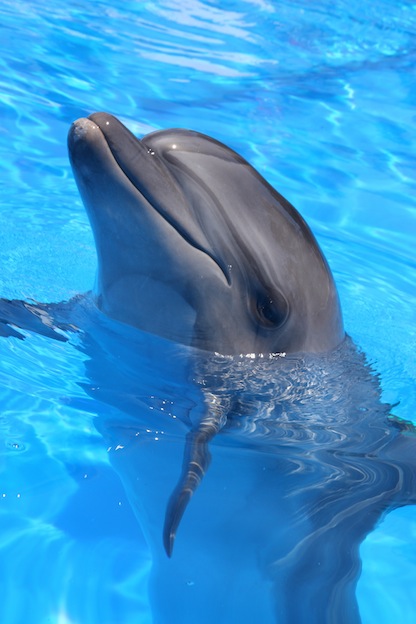
The fluke is the name of the tail, and it doesn’t contain any muscle, cartilage, or bone. Instead, it has very dense connective tissue. The dorsal fin is curved for the Bottlenose dolphin, but the overall shape of it can vary by individual. The dorsal fin is also made from connective tissue. At the forehead there is the round melon. This is where the fat is stored that allows for echolocation to occur. The eyes are located at the side of the head, close to the corners of the mouth. They don’t have very large ears so you have to look closely right behind the eyes to see them.
Distribution
These dolphins are found living in the warmer waters around the world most of the time, in the tropical oceans. Even though they can live in some cooler temperatures, they aren’t able to survive in the polar waters. They can be found in bays, around open shorelines, and even in rivers. They tend to live in water that ranges from 50 degrees Fahrenheit to 90 degrees Fahrenheit. They have been identified in the Pacific Ocean in Australia, Northern Japan, Chile, and Southern California.
Some have also been identified around the Hawaiian Islands to the West. When you evaluate the California coast, they have been found around Monterey when it gets quite warm.Nova Scotia to Patagonia and into Norway are places you will find them in the Atlantic Ocean. They have also been identified around the tip of South Africa. The majority of them though are found along the coast of the USA from Cape Code down to the Gulf of Mexico. Both the Black Sea and Mediterranean Sea are also home for the Bottlenose Dolphin. They have been seen in the Indian Ocean from Australia to Indonesia too, but this is mainly the Indo-Pacific Bottlenose Dolphin subspecies.
They may live deep in the water and come up for air every couple of minutes. They can also live close to shore and get air almost continually. Some of them have been observed with the ability to dive and remain under the water for up to 4 ½ minutes before they get a breath so there is plenty of variation.
Some have also been identified around the Hawaiian Islands to the West. When you evaluate the California coast, they have been found around Monterey when it gets quite warm.Nova Scotia to Patagonia and into Norway are places you will find them in the Atlantic Ocean. They have also been identified around the tip of South Africa. The majority of them though are found along the coast of the USA from Cape Code down to the Gulf of Mexico. Both the Black Sea and Mediterranean Sea are also home for the Bottlenose Dolphin. They have been seen in the Indian Ocean from Australia to Indonesia too, but this is mainly the Indo-Pacific Bottlenose Dolphin subspecies.
They may live deep in the water and come up for air every couple of minutes. They can also live close to shore and get air almost continually. Some of them have been observed with the ability to dive and remain under the water for up to 4 ½ minutes before they get a breath so there is plenty of variation.
(source:google/http://www.dolphins-world.com/)
No comments:
Post a Comment